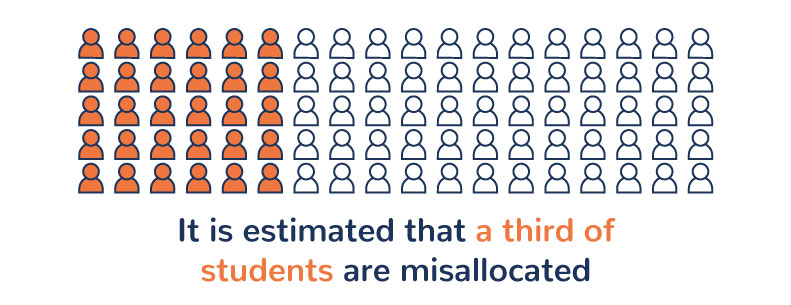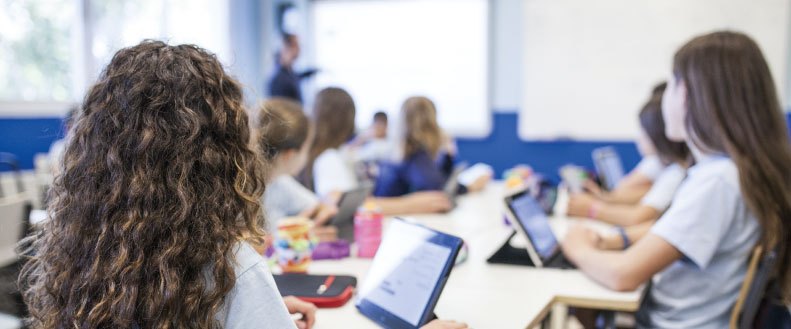The spread of learning needs among students invites some intuitive conclusions. If we are to make good on the promise to address every student’s individual needs, then it seems to make sense to place students into groups, or ‘sets’, based on their current perceived ability, rather than lumping together students with such disparate needs. The high attainers are then free to tackle more advanced content, while those lagging behind can catch up in their own time without holding back their peers. The practice of setting1 is so intuitive in fact, that the former British prime minister David Cameron once declared: “I want to see it in every single school. Parents know it works. Teachers know it works.”
The research, however, is less emphatic on the benefits of setting. The OECD, through its PISA studies, has linked ability grouping to lower overall performance of education systems while a review by the Education Endowment Foundation notes that “On average, pupils experiencing setting or streaming make slightly less progress than pupils taught in mixed attainment classes.” The report concludes: “Overall the effects are small, and it appears that setting or streaming is not an effective way to raise attainment for most pupils.” And a recent study of setting in secondary schools in England estimates that a third of students are misallocated.
As is often the case in education, our intuitions do not hold up to the scrutiny of research or the realities of implementation. While setting appears to be the obvious response to the multi-year knowledge gap, it triggers a number of unintended consequences.

The side effects of setting
In recent years, the notion of growth mindset – the belief that intelligence is fluid and can increase with sustained effort – has gained currency. But practices like setting promote quite the opposite: a fixed mindset steeped in the belief that intelligence is static, by condemning students (and their parents and teachers) to rigid judgements of their learning potential. The Education Endowment Foundation reinforces the attitudinal effects of these practices: “it appears likely that routine setting or streaming arrangements undermine low attainers’ confidence and discourage the belief that attainment can be improved through effort.” The only way to overturn these consequences is to allow for fluid movement between ability groups. This is rare in practice because it requires deliberate monitoring of each student’s learning patterns, and the constant change to each group’s composition risks disrupting stable classroom dynamics.
The result, all too often, is that setting becomes a self-fulfilling prophecy. Those students assigned to lower-ability groups are stripped of access to the full curriculum and find themselves trapped in a vicious spiral of low achievement which, to the uncritical eye, justifies their initial placement. Meanwhile, those placed in the higher sets reach an escape velocity from low expectations early on and, with access to the richest content, surge further ahead from their peers. The danger of setting, in other words, is that it perpetuates the achievement gap. Setting by ability must be understood as an issue of social justice. Often, ability groups serve as a proxy for race and socioeconomic status. The very students who would prosper from an inclusive schooling experience see their opportunities curtailed before they even get started.

The power of differentiation
In a very real sense, every group of students represents mixed abilities. Every student brings a distinct mixture of knowledge, skills, values and dispositions to bear on the classroom, informed by their prior experiences. The ideals of personalised learning must be pursued on the recognition, a celebration in fact, of every student’s individuality. Attempts to set or stream, in this regard, undermine the commitment to address the specific needs of each learner. It behoves teachers, whether they are dealing with ten students or a hundred, high attainers or mixed, in private schools or state schools, to differentiate their lessons so that the learning experience is optimised for every student.
There are positive examples of differentiation all around us. In a recent TES article, primary maths teacher Jon Parsons explains the reason behind his school’s move to mixed ability grouping: “From a social mobility standpoint, it appeared that setting was suppressing the potential of our disadvantaged mathematicians.” Parsons was swayed by research that “pointed to the benefits of mixed-ability teaching, including social equitability, narrowed diversity of attainment, and children of basic problem-solving ability being able to observe and learn from their more experienced peers.” In practice, this meant exploiting the social dynamics in the classroom by using “good quality problems” that “generate conversations between children”. Far from being a bolt-on, these activities were fully integrated within a mastery approach.
The principles of differentiation cut across subjects. Oscar Hedstrom, a secondary teacher of English in Australia, worried that setting would “underestimate the importance of peer-to-peer learning”. Hedstrom notes that the “value of knowledgeable student peers must not go unrecognised”. In this view, there is limitless potential in ‘mixed attainment’ groups because the varied levels among the students can be leveraged through peer learning. As Hedstrom observes: “It is amazing to watch a student explain an idea or skill to her peers in ways that their teacher would never think of. They operate with different language tools, different social tools and, having just learnt it themselves, possess similar cognitive structures. There is also something exciting about passing on skills and knowledge that you yourself have just mastered”. Peer learning benefits all students when activities allow them to assume multiple roles depending on their needs and interests.

Differentiation is a delicate craft, not to be taken lightly. It depends on regularly monitoring students’ progress and co-operative planning among staff to ensure that expectations for all pupils remain high and that the soft bigotry of low expectation is silenced. In her book Cleverlands, Lucy Crehan demonstrates that when these practices are upheld, mixed-ability groupings become a lever of strong educational performance across entire systems.
Yet in many quarters, the idea of differentiation has met with resistance on the grounds that it takes considerable time and effort – impractical and unreasonable to most – to design and deliver lessons that cater to diverse needs. With the advent of digital learning technologies, that is poised to change, and the examples above could well become the norm.
How technology enables differentiation
Too often, EdTech tools are thrust upon teachers as solutions in search of a problem. The debate on setting, however, is centred on a well-defined problem in need of an innovative solution. Namely, how can a teacher be supported to differentiate the learning experience for their students in ways that do not add to their workload? A sound solution will reconcile the seemingly competing objectives of reducing teacher workload and raising student outcomes.
At Whizz, we believe technology can be the great enabler of differentiation. For students, adaptive tutoring ensures they acquire the core knowledge and skills at their own pace. Crucially, and in opposition to how the ‘adaptive’ approach of setting typically operates, all students are granted full access to the same curriculum. The destination is the same for every learner: mastery of the full curriculum by the time they graduate from school. The only variable is the pace with which students proceed from one week to the next.
For teachers, the distribution of effort shifts from marking work to analysing real-time data insights into their students’ learning that inform their classroom activities. They can capture all the social benefits of a ‘mixed ability’ classroom without having their workload amplified.
If you share our belief that every child deserves a learning experience that caters to their individual needs, then we hope you will be inspired to reflect on how the technologies of today can help you overcome the constraints of time and effort and make differentiation a cornerstone of your curriculum delivery.
1 We use ‘setting’ to refer to the practice of organising students into groups within specific subjects, and ‘streaming’ when it applies to all subjects. The latter is sometimes referred to as ‘tracking’.
